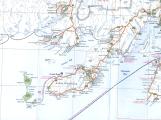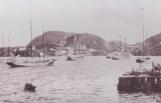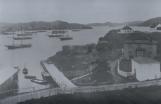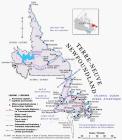2
Newfoundland was not part of Canada in 1929: it was a colony of Britain, poor and relatively undeveloped. Population was low and scattered in isolated rural fishing outports. There were no roads across the Island until the 1960s and there was not yet a road connection from St. John's to the Burin Peninsula. There was no industrial base and its scientific establishment was virutally non-existent.3
The Town of Burin is Located on the Eastern Side of the Burin Peninsula in Placentia Bay.1977
Burin Peninsula, Newfoundland,Canada

4
Burin PeninsulaThe Burin Peninsula is a long, narrow, leg-shaped peninsula which juts southwest out into the Atlantic Ocean off the south coast of Newfoundland. It is approxiamately 161 km long with a maximum width of approximately 40 km and is bounded by Fortune Bay on the west, Placentia Bay on the east and the Atlantic Ocean to the south. The coastline is indented with hundreds of small bays, inlets and coves: it is very rugged with high cliffs.
Barren rock of a volcanic and sedimentary nature dominated most of the coastal area of Burin. Debris from glacial action is sufficiently deep to allow for pockets of rough soil. There are numerous ponds, peat bogs, glacial sands, clays and gravel.
The many small settlements that developed on our off-shore islands made roads unnecessary as all transportation was by water. Today, all our island communities have been abandoned in accordance with the Goverment's centralization plan for Newfoundland following Confederation with Canada in 1949.
6
Picture of Parishoners from Wandsworth travelling in a fishing skiff to Great Burin for Sunday Services.Remembering the Sabbath Day to be kept holy was interpreted as meaning the Day should be respected as the Lord's Day, set apart solely for the worship of Almighty God and nothing but the most essential work was to be done. Because of this, a lot of extra work had to be taken care of on Saturday in preparation for the Sabbath. There was no fishing or curing of fish, cutting of wood, drawing of water,etc. done on Sunday. Business houses were closed, and in the homes, the washing of cooking utensils and sweeping of floors were often deferred until Monday.
Half or more of the congregation was dependent on boats, either dories or skiffs, for transportation from Pardy's Island, Step-A-Side, Great Burin, Bull's Cove and Epworth to Collins Cove. Incidentally, the skiff conveying the people of Great Burin to Collins Cove was not powered and had to be rowed by four or five men. This was not an easy job as you can imagine, but such was the calibre of these people and so important of their well being were their religious convictions that the people of years ago considered as nothing the hardship of having to walk miles or travel by boat to attend worship.
8
Cod drying on "flakes" on the shores of Burin. Families ashore would help in the curing of the fish located near their homes.9
Government Wharf with Collin's Cove Methodist Church in Background.1910
Collin's Cove, Dominion of Newfoundland

10
BurinWe're descendants of the English
Scottish, French and Irish too,
No person will dispute the fact
That's a very potent brew.
Yet conservative and cultured,
Hospitable as well,
An atmosphere of friendliness
As visitors will tell.
As the past weaves through the present,
In retrospect we find,
Our ancestors left a heritage
A legacy of kind.
Antegrity and honesty,
Love for our fellow-man,
A vast unageing intellect,
A pride of our homeland.
And though we travel many lands,
Or o'er the seas we roam,
Her rugged beauty calls us,
We long again for Home.
To watch again the ocean blue,
As it gently laps the shore,
To breathe its non-polluted air
What could one want for more!
So we salute our hometown,
Its present and its past,
It will always be "Home Sweet Home,"
As long as life shall last.
11
Fleet of Schooners in Burin Harbour Taken from Collin's Cove.October, 1900
Collin's Cove, Dominion of Newfoundland

12
BurinAs we search back through history
We find that Burin Town
Was one of the first established
For many miles around.
The Peninsula thus named,
Date back to days of yore,
When foreigners came aroaming
In search of fish galore.
It would take a lot of telling
To do justice to this town -
Steeped so deep in history
And its people or renown.
Its natural land-locked harbour,
Its high protective hills,
Its lovely dales and valleys
With many streams and rills.
There's a panormic beauty
In her rugged rock bound shore,
You view historic "Cook's Lookout"
a monument of yore.
Its triangle of three churches,
Spires pointing to the sky
As if in adoration,
To a diety on high.
Some other faiths of later years
Were welcomed- as they should,
Our motto: "Live and let all live"
A closer brotherhood.



